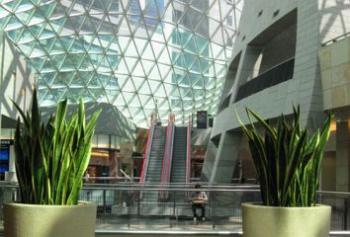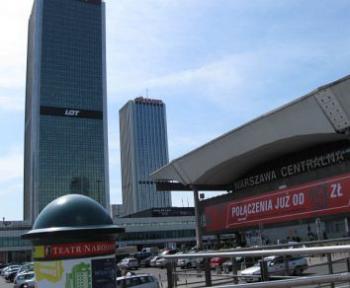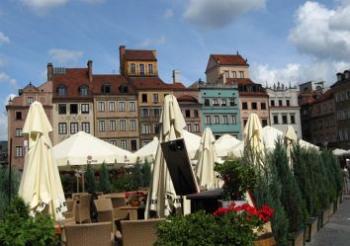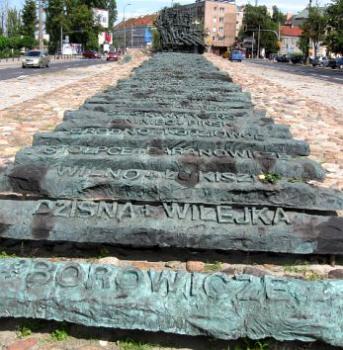Midway between the Baltic Sea and the Carpathian Mountains – 350 kilometers either way – lies Warsaw, the capital of Poland. Nearly wiped off the map in 1944, today booming in its own modernity, yet complete with an Old Town.
The Nazi bombers did a thorough job, only 15% of the city was left standing. 400.000 Jews were no longer a problem, the last 60.000 went with the Ghetto in the 1943 Revolt. The inferno of 1944 was a last attempt by the Varsovians to liberate their city in the Warsaw Uprising, price 200.000 lives.
The grim history of Warsaw colors no doubt the way tourists speak and think about it. Conducting a beauty contest among European cities with Warsaw as one of the participants, is a bit naive. However, this is what the travel portal Tripadvisor.com did in a recent poll – appointing Warsaw the ugliest city in Europe and the third worst place to eat out. The voters may have visited Warsaw, hardly today or yesterday though – a city where constant change is the rule.

There is one more bias; a special type of potted plant actually – in most countries a hated plant, neglected and banished to the home’s darker corners – whereas in Warsaw, it almost enjoys royal status, possibly because it never gave up to bombs, choking dust and smoke or collapsing ruins, an idolized survivor. That’s of course “mother-in-law’s sharp tongue”, or more correctly: Sansevieria, each leaf of which is sculptured like a bayonet.
You see them everywhere – in public offices and libraries, in hotels and shopping centers. They are like soldiers on guard, the slim and tall type is popular, uniformly dressed in darker green with a discreet pattern, its sharp edge often in a lighter color, always well nourished and taken care of. Modest and tough, it’s a true representative of Warsaw, and as such, not the candidate of a beauty contest.
Out of the Heaps
The German attacks on Warsaw are repeated several times every day – at noon in English – in a little cinema at the Warsaw Historical Museum. Dwelling on a 65 year old tragedy could look like exploitation. However, the 1944 Warsaw Uprising did have an incredible aftermath – the defeated city was continually bombed with the sole purpose to make it unlivable, also for the approaching Russian Army. Today’s travelers watch and listen disbelievingly. It may take a while before they think of Warsaw in terms of beauty.

The magnitude of the reconstruction – taking place under a postwar communist regime forced upon them – makes you wonder whether the Varsovians and Poles in general are made of a particular stuff. It’s a fact they are a homogeneous population, which possibly explains an ability to agree and join forces. Today, the city on the Vistula river has a population of 1.7 million, Greater Warsaw 2.3 million.
Out of the ruin heaps grew apartment blocks of Russian design, gradually overshadowed by skyscrapers in glass, concrete and steel. The meticulous rebuilding of the old city core was made possible by input from authorities and citizens alike; pieces of information, perhaps a map or photos spared by the fires – and also good luck, in that architect students had during the inter-war period mapped and described the oldest quarters in detail.
Poland is back in the European family – since 2004 as a EU member. On the European scene, Warsaw and Poland now and again play the part of a very demanding negotiator, requiring extensive advantages for themselves, as if they had forgotten the ground rules of co-existence between nations. It is admittedly a nation reassuming its international position and coming to terms with a past that took them from all-embracing oppression to freedom and democracy.
Among Monuments
Monuments are like buttons – if you activate them, simply by going there, you get messages, in Warsaw’s case often dealing with suffering, murder and incredible human cruelty. New buttons come along, their messages old but the presentation new and made for the future, a lasting key to the identity of Warsaw. One example is a little railway from 1995 carrying a wagon full of crosses, its sleepers marked with the destinations of the “Fallen an Murdered in the East”. Three million Poles were sent to Siberia, half of them leaving no trace.

Umschlagplatz is from 1988, so quiet and anonymous that you risk walking past it. Grayish marble with inscriptions, a monument shaped like an open freight car. From here, 265.000 Ghetto members were sent by death trains to Treblinka for extermination. If you need a mental break, take a side trip to the Arkadia shopping center, a live monument to present-day Warsaw. Less lively is the Warsaw Uprising Monument, which practically grows out of a slim green glass building – soldiers in postures indicating highest preparedness, probably the reason why a detached group of men hurry into the sewers, the whole lot backed by the Supreme Court.
When you enter the Old Town, you should stop awhile to get things right – the buildings and city wall that you see, are not older than around half a century, so perfectly reconstructed that it gained World Heritage status. One collection of facades – on the Market Square – survived partly. They occupy the so-called Dekert side of the Square, eight narrow buildings in pleasant colors, their rooms connected to house the Historical Museum of Warsaw.
Open windows help you hold on to the present, unfolding on the Square below, while real-life mothers-in-law, strong and serious, direct you through the museum’s labyrinth with a sporadic nod and a pointing finger. Back on the Square, there is the Warsaw Mermaid to defend you with her sword. The Little Insurgent, a small boy with a gun and too big a helmet, is so dear that people adorn his statue with flowers. In real life, he was probably a smart messenger. You’ll find him on the city wall near the fort of Barbakan.

A Different Focus
Hard to pronounce, but the parade street of Warsaw is made to impress you – Krakowskie Przedmiescie, once the road to Krakow, the old capital. The Royal Castle, a tourist favorite in a shade of red, sends you off. After the Presidential Residence things get more relaxed – lots of space, buildings to admire, street musicians to listen to and people to watch – as you proceed toward the center of modern Warsaw, an area of fast food and skyscrapers, the gem of which is a Russian monster – the Palace of Culture and Science.
Listening to Chopin in the paradise of Lazienkowski Park, the “ugly” nomination may dawn on you again. Bad mention is better than no mention, say some – the tourist authorities could simply adopt the new title and promote Warsaw accordingly. That is not likely to happen, and an attempt at dialogue with Tripadvisor might be brushed aside with a statement: “Freedom of the press!”
The situation calls for analysis – how come an undeniably beautiful city is rated the ugliest. Looking at the available information material, it’s a fact that war monuments are promoted heavily, and there is the constant film in the museum. These things do make impressions on tourists and pop up in their minds whenever Warsaw is mentioned, this very article is one example. Perhaps the time has come for Warsaw to play down the horrors – and broaden their focus to also include the lighter sides of itself.